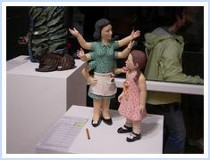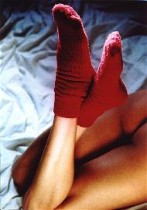[Ed. note: Artblog contributor Colette Copeland’s critical writing class at Penn went to First Friday, too. Here’s what a couple of them had to say.]
Across the sculpture-craft divide
 The “Mastery in Clay Auction Celebration” on exhibit at the Clay Studio through Oct. 22, showcases a diversity of styles within the medium. Mary Roehm employs traditional ceramic techniques in her piece “Pale Blue Celadon Bowl”. The beauty is found within the simplicity of its shape and angelic color. Like Roehm’s piece, Karl Radasch’s “Bowl and Terracotta Glaze” displays traditional mastery of pottery thrown on a wheel. However, the elaborate glaze in complementary colors such as pinks and greens, on top of whites and browns, makes this piece anything but conventional (left, a piece by Cynthia Consentino).
The “Mastery in Clay Auction Celebration” on exhibit at the Clay Studio through Oct. 22, showcases a diversity of styles within the medium. Mary Roehm employs traditional ceramic techniques in her piece “Pale Blue Celadon Bowl”. The beauty is found within the simplicity of its shape and angelic color. Like Roehm’s piece, Karl Radasch’s “Bowl and Terracotta Glaze” displays traditional mastery of pottery thrown on a wheel. However, the elaborate glaze in complementary colors such as pinks and greens, on top of whites and browns, makes this piece anything but conventional (left, a piece by Cynthia Consentino).Simply crafted common pieces of pottery, such as cups, saucers, and plates, assembled in an uncommon way gives Benjamin Schulman’s “Stack # 26” a modern edge. Numerous opaque black pieces of slightly differing sizes and shapes are stacked up in one long tower, creating a unique sculpture that brings together traditional and contemporary art.
If Schulman’s piece is the mid-point between traditional pottery and contemporary sculpture, Cynthia Consentino’s “Family Portrait: Mother and Daughter” falls very distinctly into the contemporary sculpture category. Both the title and the initial viewing of the work would lead one to believe that this is a conservative family piece. However, upon closer inspection one observes multiple arms and hands sprouting from the mother’s back, and an ear pressed on to the daughter’s stomach. Is this supposed to be commenting on the clichés of demanding children not listening to their parents nor realizing that their parents “only have two hands”? Instead of simply admiring the craftsmanship, I found myself wondering about possible familial or cultural implications and meanings within the work.
–by Jessica Gerber
Red socks for AIDS research
 Naked fashion models in shapeless, calf-length red socks? All in the name of AIDS research funding from photographer Rayzor Bachand’s exhibit at the Qbix Gallery that opened Friday, Oct 7. The obvious humor and sexual appeal of the exhibit is in direct opposition with the reason for creating this show, which will go on tour nationally after one month in Philadelphia. Bachand’s prints, inspired by Philadelphia native fashion model, Gia Carangi, who died from AIDS complications in the 1980s, are on sale at the gallery to raise funds for AIDS research.
Naked fashion models in shapeless, calf-length red socks? All in the name of AIDS research funding from photographer Rayzor Bachand’s exhibit at the Qbix Gallery that opened Friday, Oct 7. The obvious humor and sexual appeal of the exhibit is in direct opposition with the reason for creating this show, which will go on tour nationally after one month in Philadelphia. Bachand’s prints, inspired by Philadelphia native fashion model, Gia Carangi, who died from AIDS complications in the 1980s, are on sale at the gallery to raise funds for AIDS research.
The show definitely succeeded in getting attention this First Friday, not only because of the erotic nude photography, but also because it was raising money for an important cause. In fact, the combination of those two strategies reminds me of that calendar project from England where elderly women from a small town put out a nude calendar of themselves to raise money for leukemia.
The one room gallery even looks like a sales floor, marketing and selling the prints for AIDS research. The show draws in the audience with nudity and then forces them to examine the completely out-of-place red socks in the photographs.
Each image is titled individually to correlate to the role of the socks in the image. “Musical Socks” features a women playing the piano with her feet in a very intimate and casual pose. The socks signify the individuality of each woman and bring to mind that each AIDS patient is an individual.
The show will run until Nov. 4.
–by Anastasia Kouriatovaroehm, maryradasch, karlschulman, benjaminconsentino, cynthiabachand, rayzor









